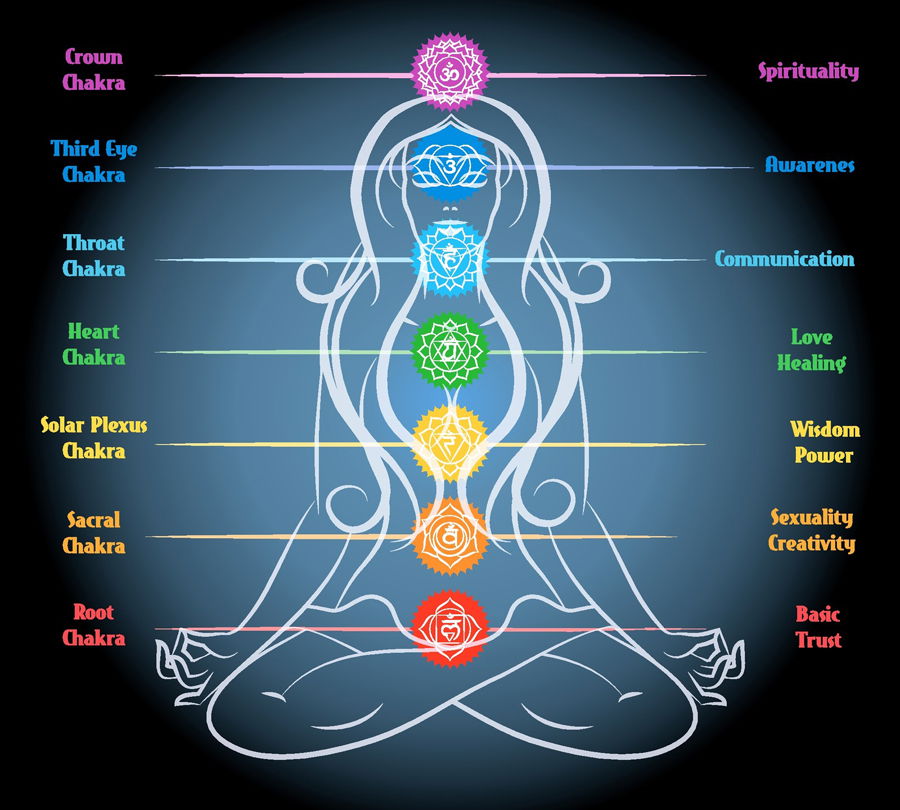Chakras amd how to keep them balanced

Chakras are the energy centers of the body. They are located in the astral body along the spine, starting at the base of the spine and running upwards to the crown of the head. The Chakras coincide with a gland in the physical body and each radiate a specific color and energy. Since each chakra relates to specific spiritual, emotional, psychological and physical aspects of our being, it is said that the blockage or malfunction of the chakras can lead to physical, psychological and emotional disorders. The conscious awareness and the balancing of these energy centers on the other hand is believed to lead to well-being and good health. That is one of the purposes of asana practice: to stimulate and balance the chakras or energies in the body.
1. Muladhara Chakra – Root Chakra Muladhara Chakra is located at the base of the spine between the anus and the genitals. It radiates the color red and represents the element earth.It is characterized by the emotions of survival, stability, ambition and self sufficiency. When this chakra is out of balance, a person might feel unstable, ungrounded, lack of ambition, lack of purpose, fearful, insecure and frustrated. However when Muladhara Chakra is balanced a person might feel stable, confident, balanced, energetic, independent and strong.The mantra of Muladhara Chakra is ‘Lam’.Practicing the following postures helps to balance Muladhara Chakra: Tree Pose (Vrkshasana) and Mountain Pose (Tadasana).
2. Svadhishthana Chakra – Sacral Chakra The second chakra, Svadishthana Chakra, is located at the lower abdomen, about four fingers below the navel. It radiates the color orange and represents the element water.The attributes of Sacral Chakra are the basic needs for sexuality, desires, creativity and self-worth. When imbalanced, a person might feel emotionally explosive and irritable, lacking of energy and creativity, manipulative or obsessed with sexual thoughts. When Svadhishthana Chakra is balanced, a person might feel positive, vital, satisfied, compassionate, and intuitive.The mantra of Svadhishthana Chakra is ‘Vam’.You can work on balancing Svadhishthana Chakra by practicing balancing poses like Crow Pose (Kakasana) or standing poses like Triangle Pose (Trikonasana).
3. Manipura Chakra – Solar Plexus Chakra Manipura Chakra or Solar Plexus Chakra is located above the navel at the solar plexus (between the navel and the bottom of the rib cage). It represents the element fire and thus radiates yellow color.This chakra is characterized by energy and emotions like ego, anger and aggression. An imbalance of Manipura Chakra can manifest itself physically by digestive problems, liver problems or diabetes. On an emotional level one might struggle with depression, lack of self-esteem, anger and perfectionism. By bringing the chakra into balance one might feel energetic, confident, productive and focussed.The mantra of Manipura Chakra is ‘Ram’.Working on Manipura Chakra can be done in poses like Forward Bend (Paschimottanasana), Cobra Pose (Bhujangasana) and Bow Pose (Dhanurasana).
4. Anahata Chakra – Heart Chakra Anahata Chakra, Heart Chakra, as the name implies, is located in the heart region. Its color is green and the element is air.This fourth Chakra is the seat of balance within the body, characterized by emotions of love, attachment, compassion, trust, and passion. When Anahata Chakra is out of balance a person might deal with emotional issues like anger, lack of trust, anxiety, jealousy, fear, and moodiness. By harmonizing this chakra, you might feel compassionate, optimistic, friendly, motivated, understanding, and caring.The mantra of Anahata Chakra is ‘Yam’.Heart Chakra can be balanced by practicing poses like Half Bridge Pose (Ardha Setubandhasana), and Fish Pose (Matsyasana).
5. Vishuddha Chakra – Throat Chakra The fifth Chakra, Throat Chakra, is located at the base of the throat, coinciding with the thyroid gland. Its color is bright blue and the element is space.Vishuddha Chakra represents inspiration, expression, faith, and the ability to communicate. Imbalance of the Throat Chakra may lead to timidity, quietness, a feeling of weakness, or the inability to express your thoughts. Balance of the Throat Chakra can manifest itself by creativity, positive self-expression, constructive communication, and satisfaction.The mantra of Vishuddha Chakra is ‘Ham’.Throat Chakra is stimulated in poses like Shoulderstand (Sarvangasana) and Plough Pose (Halasana).
6. Ajna Chakra – Third Eye Chakra Ajna Chakra (pronounced as ‘Agya Chakra’) is located in between the eyebrows. It is free of element but does have a color: indigo blue.Third Eye Chakra is often used as a focal point during asana practice to bring more concentration and awareness. It is said that meditation on Ajna Chakra destroys the karma of past lives and gives liberation and intuitional knowledge. Its attributes are intelligence, intuition, understanding, insight, and self-knowledge. When this chakra is out of balance, one might feel non-assertive, afraid of success, or on the contrary, be egoistical. The imbalance of Ajna Chakra can manifest itself on a physical level by headaches, blurry vision, and eye strain. When Ajna Chakra is balanced, one is his own master without fear of death and free of attachment to material things.The mantra of Ajna Chakra is ‘Om’.
7. Sahastrara Chakra – Crown Chakra The seventh Chakra, Sahastrara Chakra, is located at the crown of the head. Also, this chakra doesn’t represent an element. It is violet and/or white in color.Sahastrara Chakra is the center of spirituality, enlightenment, dynamic thought, and energy. It allows for the inward flow of wisdom and brings the gift of cosmic consciousness. When out of balance, one might suffer from a constant sense of frustration, no spark of joy, and destructive feelings.The mantra of Sahastrara Chakra is ‘Aum’.Balancing Sahasrara Chakra can be done by practicing Headstand (Shirshasana).
*Source:Arhanta yoga